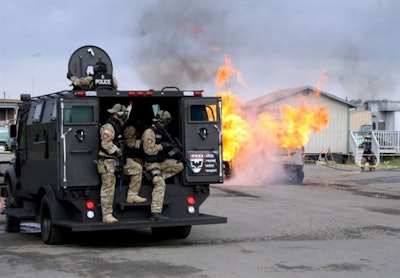 Photo: Alameda County Sheriff's Office
Photo: Alameda County Sheriff's Office
Urban Shield is a big reason why northern California law enforcement agencies work so smoothly and effectively together on mutual-aid calls with the tactical temperature rises. Urban Shield 2011 arguably provided the toughest logistical test to date with its more than 4,000 participants.
The well-oiled teamwork starts at the top, becomes contagious, and filters down throughout all of Urban Shield. The leadership from Urban Shield's host agency, the Alameda County (Calif.) Sheriff's Department is on display from up and down the entire chain of the command.
To set the tone, Sheriff Gregory J. Ahern lays out six goals:
- Integrate critical infrastructure sites and their onsite personnel using a collaborative unified command response to emergency/disaster events.
- Integrate EMS personnel with law enforcement force protection through the use of "warm zone" environments with a focus on immediate victim medical intervention and evacuation.
- Evaluate regional Explosive Ordnance Disposal (EOD) teams' core competencies and response capabilities.
- Test mobile command communications between personnel in multiple affected areas and their associated area commands.
- Integrate mass transportation entities and onsite law enforcement personnel using a unified command framework to evaluate core competencies.
- Evaluate core competencies in HazMat and search-and-rescue operations, including regional cooperation and interoperability.
"It's critical that we continue to expand regional collaboration and preparedness levels for all first responders—law enforcement, fire, emergency medical services, and hospitals," Sheriff Ahern adds. "Testing our abilities over a broad spectrum of disciplines and scenarios within the confines of a coordinated training and exercise venue, we have become better prepared to address future disasters."
So how does all this translate into the "real world"? The ACSO SWAT officers who were involved in a shootout with a dangerous, wanted suspect in Mendocino County, Calif., credit their survival to Urban Shield's heavy emphasis on realistic training scenarios.
Several ACSO SWAT members involved in the dangerous, tiring Mendocino manhunt participated in the Urban Shield 2011 SWAT competition that ran for 50 continuous hours.
The same is also true for a number of other SWAT team participants involved in the dangerous, extensive manhunt for a multiple murder suspect in Cupertino, Calif. Both suspects in Mendocino and Cupertino met a violent end. However, they didn't "take anyone with them" due to the brave professionalism by all involved officers.
Shortly after the completion of Urban Shield 2011, the real world once again interjected itself onto Northern California officers in the form of the Occupy movement. This has been seen most notably in Oakland, which experienced violent clashes between protesters and police.
The Oakland Police Department, which is severely understaffed, wisely requested mutual aid from several Northern California law enforcement agencies. The early morning evictions and dismantling of the increasingly dangerous, unsanitary "tent city" in front of Oakland City Hall was relatively incident free, despite numerous arrests.
After the evictions, protesters returned en masse to battle police by throwing rocks, bottles, and paint. Police responded with chemical and less-lethal munitions. Ultimately, the Oakland mayor allowed the protesters to return to their tent city, which was reminiscent of the Vietnam War where military tactics often played out as "take a hill, give it back."
What's significant about each of these "real world" events is they involve mutual response from multiple law enforcement agencies. From an observer's viewpoint, in each situation the mutual-aid cooperation was nearly seamless. Everyone worked together as a team.
Such teamwork just may be the most significant, and valuable thing about Urban Shield. Given today's continuing sour economy, it's predictable that law enforcement is becoming increasingly reliant on mutual-aid response to handle the more complex events.




















